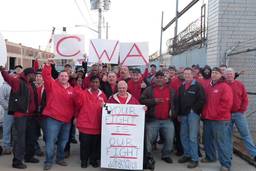When workers in a labor struggle are forced to agree to major concessions, labor leaders and allies often find ways to recast the defeat as a long-term victory. Often, they say that losing a tough fight opened up workers’ eyes to the lengths they must go to in order to win the next one.
In 2011, for instance, labor circles widely celebrated the massive Wisconsin protests of Governor Scott Walker’s anti-union bill, which stripped public employees of collective bargaining rights and forced unions to give massive concessions in terms of wages and benefits. Still, many felt that Wisconsin was a turning point because it inspired unions to fight back in ways previously thought unimaginable — the crowds of protesters, numbering nearly 100,000, continuously occupied the Capitol for three weeks. Even after labor lost its bid to recall Walker, AFL-CIO President Richard Trumka declared, “We wanted a different outcome, but Wisconsin forced the governor to answer for his efforts to divide the state and punish hardworking people. Their resolve has inspired a nation to follow their lead and stand up for the values of hard work, unity and decency that we believe in.”
No matter what was given up at the bargaining table — even if the bargaining table was thrown out the window — rarely will a labor leader come out and say that a loss was a bad one, or that mistakes were made. Labor leaders, after all, are subject to the same fear of mistakes jeopardizing their next campaign as other elected officials. And for the workers, there’s basic human psychology at hand: People like to see that their struggles weren’t for nothing.
But while spinning defeat into quasi-victory may make activists feel better, do massive losses really inspire future efforts? After one such setback in the Red River Valley, which spans the border between North Dakota and Minnesota, union activists are wrestling with this question.
When the cross-country Solidarity of Summer labor tour stopped last Saturday in Moorhead, Minn., the talk among local labor activists was of the 22-month lockout of sugar workers, which ended in April with a bitter loss. After contract negotiations went sour in 2011, Crystal Sugar locked out 1,300 workers — members of the Bakery, Confectionery, Tobacco Workers, and Grain Millers (BCTGM) union — at five plants in Minnesota, Iowa and North Dakota. For nearly two years, the workers held out, turning down the contract, which they felt was concessionary, in four separate votes.
But this spring, the locked-out workers reached the end of their financial resources and those of the union, and decided on the fifth vote to accept the contract. The resulting agreement raised their healthcare costs and reduced their union rights. (To read more on the lockout, read my feature story last year, “The Shock and Slow Bleed of Lockouts.”)
The lockout exacted a bitter toll on the union, which emerged from the 22-month fight with its size, and therefore its leverage, reduced by half. Over the course of the nearly two-year struggle, approximately 600 of the 1,300 workers found other jobs and did not return to work when the contract deal was reached. Instead, the company kept on the scab replacement workers as contractors, ineligible for the union.
“They got their asses kicked,” says Dana Hillius, president of the Northern Plains United Labor Council of North Dakota, the local AFL-CIO affiliate that coordinates unions for the Northern Plains of North Dakota, of the group’s efforts. But he quickly notes the bright side: An opportunity for more creative organizing. “I think, though, it’s been energizing to look at the kind of tactics that we were talking about doing in North Dakota — it’s a lot of different ideas that have never been done here before, even if they didn’t come to fruition. People are talking about more direct action and not just picketing.”
Others say that the lockout woke people up and that labor would be more vigilant and ready for the next fight with management. “I know of no [previous] lockouts in the Red River Valley and I have been active since 1978. ‘Lockouts’ were you locked yourself out of your car, not you’re locked out of your job,” says Mark Froemke, president of the Western and Red River Valley Area Labor Council. “I think what happened is that for a lot of people they understood that they need their union and they need to fight and protect it. And the boss, if you don’t defend yourself, will take advantage of you and screw you in the end.”
“I think until everybody in the working class recognizes that they are getting stumped on, that it’s not going to get better,” says Jason Allison, a member of United Steelworkers Local 560 who works in Gwinder, N.D. “I know I have woken up. I think we really had to be turning a blind eye to not see what is going on.”
Even elected state legislators weighed in on the possible advantages of the outcome. “It is tough for me to say to what degree good came out of it,” says Minnesota State Rep. Ben Lien. “I am not a member of that union; I am not feeding my family with that job. I think some good things did come out of it: Getting people to look at the situation and say, wow, this is an important matter. I think it really opened folks’ eyes and got people behind the union movement.”
But not everyone sees the defeat in such an optimistic light. Twenty-year Crystal Sugar veteran Scott Ripplinger of East Grand Forks, Minn., a union shop steward who was among those locked out, believes that the fight’s lackluster conclusion will discourage workers in the region. Ripplinger was fired after the lockout ended; he says the company accused him of disorderly conduct and of threatening and hitting scabs. Ripplinger believes, however, that his firing and that of another union activist were meant to deter future organizing within the already greatly reduced group.
“They didn’t want people like me,” he says. “They didn’t want me to recruit those scabs and turn them into a union activist like myself.”
Ripplinger also believes the lockout and loss will frighten rather than embolden unions at other plants.
“I wish it would really prop up the support and increase the will to fight, [but] I think it’s made a lot of union workers scared,” says Ripplinger. “People aren’t gonna want to fight that long when they saw us fighting for 22 months and then accept a contract that was worse than the original offer.” (Although the wording was the same, the contract was worse in that after so many workers left, it covered dramatically fewer employees and left the union with less leverage.)
To those who say the lockout strengthened the ties of the labor movement as a whole, Ripplinger points out some of the details of the 22-month saga. The leaders of the BCTGM union tried to push a “yes” vote on the members four times, he says, despite the fact that the “no” vote section was well-organized enough to repeatedly defeat it. This is a common story: Leadership often pushes the collective to settle against their wishes out of fear of exhausting the union’s limited financial resources. Ripplinger says that the constant fighting between the leadership-backed “yes” group and the “no” group prevented the organization from being united in confronting the company.
“We didn’t really fight. We weren’t allowed; we were kinda handcuffed by our leaders and their purse,” says Ripplinger. “I think we need to get back to labor leaders of old who were willing to fight tooth and nail, side-by-side with the rank and file.”
Ripplinger believes that labor as a whole will only start winning the big fights again if it has frank conversations that most leaders aren’t comfortable with — about what goes wrong during labor struggles such as the Crystal Sugar lockout and about putting everyday workers back in charge of unions. Ripplinger says events like the Summer of Solidarity tour, which aims to connect union members around the country, is the kind of thing the movement needs.
“We need organizations like the AFL-CIO to back things like the Summer of Solidarity tour and really have these small labor movements, and that’s what’s going to build our support,” says Ripplinger. (Summer of Solidarity was funded by crowdsourcing efforts on Indiegogo.)
For his part, Hillius agrees that workers need more than just chest-beating about the valiance of the fight; he says labor officials like himself must also have the courage to ask tough questions.
“I hope we realize the good things to come from this lockout and take them,” says Hillius, but he also acknowledges that “we need to admit when the union don’t do something right and do something different.”
As the AFL-CIO debates new models of organizing, including allowing closer coordination of the labor movement, some say it must take a hard look at its internal structure before trying to draw in new allies. Along the Summer of Solidarity tour, plenty of on-the-ground activists like Scott Ripplinger are hoping that the AFL-CIO looks at lockouts like Crystal Sugar and recognizes the need for a leadership overhaul.
“We need a big victory to revive the labor movement,” Ripplinger says, “But we aren’t going to be able to do that ‘til we give rank and file control over the purse strings.”
This is the fourth in a series by In These Times staff writer Mike Elk, who is traveling for two weeks with the Summer of Solidarity tour. To help In These Times cover his travel expenses and to send more reporters to cover grassroots activism around the country, donate here.









